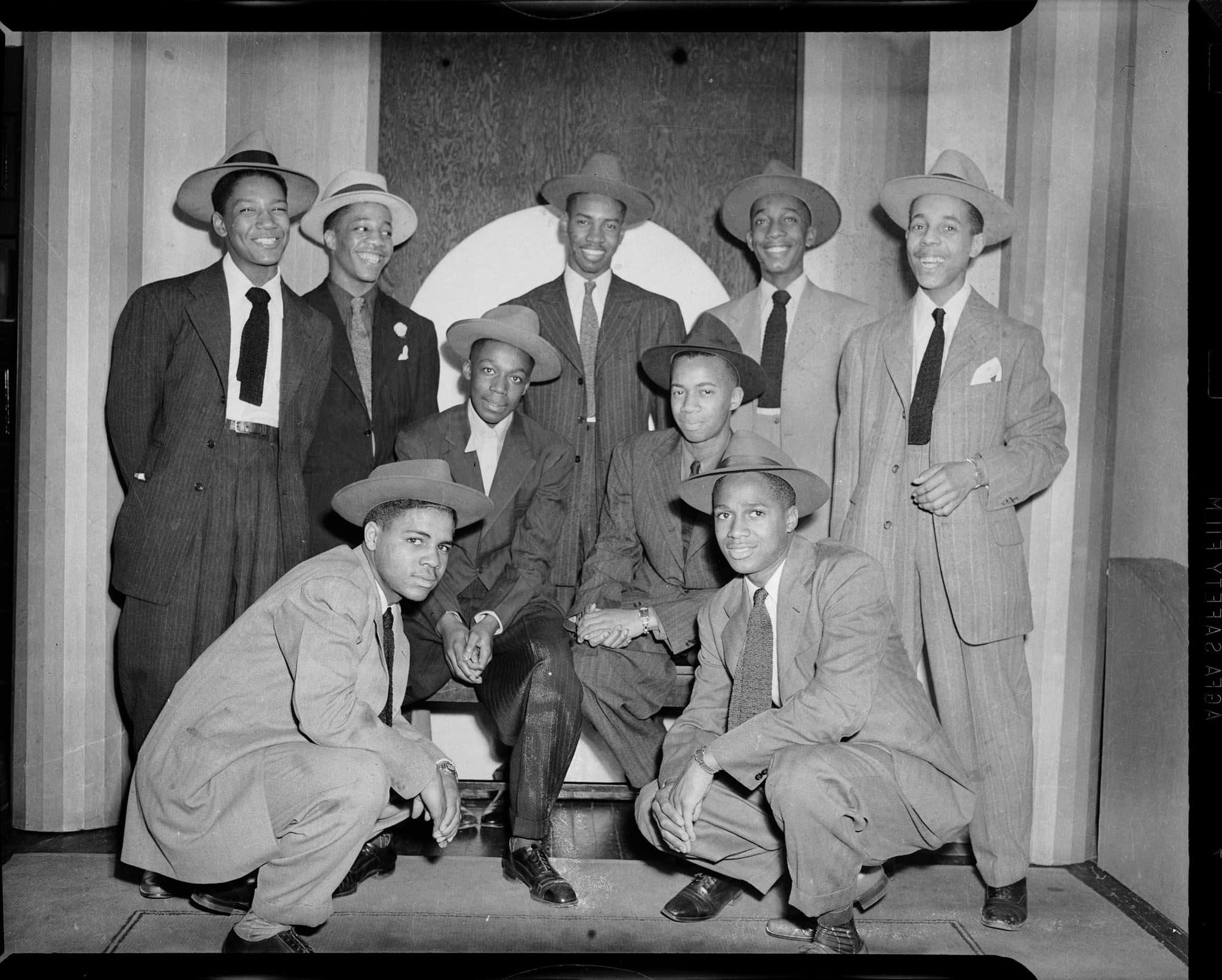Imagine a time when clothes were more than just a cover-up. They were a sign of resistance, a way to show off your culture, and a symbol of freedom. In the 1940s, the zoot suit emerged as a powerful statement in the face of social change. These flamboyant suits, with their long jackets, wide trousers, and eye-catching colors, became a symbol of rebellion for African American youth. As we take a closer look at the zoot suit, we’ll uncover its origins, its impact on jazz music and Hollywood movies, and its continued influence on fashion and culture today.
The Rise of a Cultural Phenomenon
Step back in time to the 1930s, as the sounds of jazz pour out of Harlem nightclubs. Amidst the rhythm and energy, a new style was emerging—the zoot suit. Originally called “drape suits,” these outfits were all about loose, flowing lines, eventually evolving into the iconic zoot suit silhouette we recognize today.
High-waisted pants hugged the hips before flowing down to tightly cuffed ankles. The jackets were equally dramatic, with wide shoulders and a long length that often reached the knees. Even during wartime fabric restrictions, these suits burst with vibrant hues and bold patterns. To top it off, a fedora or a pork pie hat sat jauntily on the head, a long key chain dangled, and pointed shoes added an extra touch of swagger.
But the zoot suit was much more than a fashion statement. For marginalized communities, particularly Mexican American youth known as Pachucos and African American jazz enthusiasts called Hepcats, it became a symbol of resistance—a way to reject societal norms and celebrate their cultural heritage.
Challenging the Status Quo
The zoot suit’s extravagance during World War II, with its emphasis on rationing and practicality, was seen as a challenge to the status quo. Wearing one became a bold act of defiance that exposed the simmering racial tensions of the time.
The impact of the zoot suit resonated far beyond the streets. It found its way onto the silver screen in films like “Zoot Suit,” solidifying its place in American cinematic history. Its influence spilled over into the music scene, with jazz musicians embracing the style both on and off the stage. Even the world of theater felt its power, inspiring Chicano playwright Luis Valdez’s acclaimed play, also titled “Zoot Suit.”
The Enduring Legacy of the Zoot Suit
The legacy of the zoot suit continues to resonate today. It serves as a potent reminder of the power of self-expression and the role fashion can play in shaping cultural identity. Contemporary designers still draw inspiration from its bold silhouette and rebellious spirit. The zoot suit’s periodic resurgences in popularity show that its message of individuality and defiance remains as relevant as ever.
Zoot Suits: Deconstructing a Myth of Illegality
Despite common misconceptions, zoot suits were never illegal. The violence associated with them stemmed from social tensions and prejudices, not legal restrictions.
Why Were Zoot Suits Considered a Threat?
Think about the 1940s: World War II is raging, resources are scarce, and everyone’s feeling the pressure. Zoot suits, with their flashy style and generous use of fabric, stuck out. To some, it seemed unpatriotic to wear such extravagant outfits when soldiers were overseas and fabric was being rationed.
This resentment, mixed with existing prejudices, boiled over into the Zoot Suit Riots. Fueled by deep-seated racism and social unrest, the zoot suit became an easy target—a visible symbol of everything some people disliked about the changing social landscape.
The Takeaway
- Zoot suits were more than just clothes; they were a statement. For marginalized groups, the zoot suit was a way to express their identity and challenge societal norms.
- Wartime anxieties and prejudices collided. The zoot suit became a lightning rod for anxieties about patriotism, race, and social change.
- The Zoot Suit Riots exposed the ugly truth of prejudice. These events weren’t simply about fashion choices; they were about deep-seated racism and inequality in American society.
- Zoot suits were never illegal, but the perception that they were highlights how prejudice can be just as powerful as any law.
Is It Illegal to Wear a Zoot Suit Today?
You might be surprised to learn that it’s totally legal to wear a zoot suit today. The Zoot Suit Riots were a dark chapter in history, fueled by prejudice and wartime tensions, not by any actual law against the clothes themselves.
While there were attempts to demonize zoot suiters and paint them as unpatriotic or even criminal, wearing one was never against the law. The riots themselves were a tragic example of how fear and prejudice can turn into violence.
So, if you’re thinking of rocking a zoot suit today, go for it. It’s a powerful way to celebrate individuality and cultural expression. Plus, you’ll be rocking a piece of history with a story to tell.
Can a White Person Wear a Zoot Suit?
The question of whether someone outside of the Black and Latino communities can wear a zoot suit without being disrespectful is complex. It’s not like there’s a law against it today, but with its history so deeply rooted in those communities, it requires careful consideration.
Remember, these suits weren’t just a fashion statement. In the 1930s and ’40s, they were a way for Black and Latino youth to express their identity in a society that often tried to silence them. The Zoot Suit Riots of 1943, where white servicemen and Los Angeles police attacked Mexican American youth wearing zoot suits, exemplified the racial tensions of the time.
Even today, the zoot suit’s shadow looms large. It pops up in fashion, music, and art, reminding us of those who dared to be different. If someone who isn’t Black or Latino wants to wear one, they must do so with a deep understanding and respect for its past.
Why Was the Zoot Suit Considered Inappropriate?
The zoot suit’s extravagance didn’t sit well with everyone, and there are several reasons why.
Cultural Appropriation
Some felt that zoot suits borrowed from Black culture without understanding or respecting it. The exaggerated features of the zoot suit felt like a caricature to some, disrespecting a core part of their identity.
Wartime Austerity
During World War II, resources were scarce, and people were asked to conserve. The zoot suit, with its abundance of fabric and flashy accessories, felt insensitive to those making sacrifices for the war effort.
Racial Prejudice
Let’s be real, a lot of the negativity towards the zoot suit boiled down to prejudice. Mexican Americans and African Americans were already facing discrimination, and the zoot suit, whether intentionally or not, became a way to visually distinguish themselves. This made them targets for hostility and violence, as tragically illustrated by the 1943 Zoot Suit Riots.
Conclusion
The zoot suit remains a powerful symbol of cultural expression and resistance. Its history is a reminder of the importance of understanding and respecting the cultural significance of clothing and the dangers of prejudice and discrimination. While its legacy is complex, the zoot suit continues to inspire and intrigue, reminding us that fashion can be a powerful tool for self-expression and social change.
Explore Further
Discover more about American culture and history:
- Discover the hidden gem of boilder auto court hwy 91 las vegas nv, a historic motel that offers a unique blend of vintage charm and modern amenities.
- Immerse yourself in the poignant storytelling of crow country endings, a novel that explores the complexities of human relationships and the search for redemption.
- Plan your perfect Hawaiian getaway with detailed directions to pearl harbour from honolulu with directions.
- Stay informed with the latest news and events happening at holden’s ranch news.
- Dive into the captivating world of la côte basque 1965 full text, a literary masterpiece that transports you to the glamour and intrigue of the French Riviera.
- Check out the upcoming events and activities at regin watter calendar, a community hub that offers a wide range of programs.
- Grab a bite to eat at san ysidro mcdonald’s, a convenient stop for a quick and satisfying meal.
Key Points:
- The zoot suit emerged in the 1930s as a “drape suit” with loose, flowing lines.
- It featured high-waisted pants, long jackets, vibrant colors, and accessories like fedoras and pointed shoes.
- The zoot suit became a symbol of resistance for marginalized communities, particularly Mexican American and African American youth.
- It challenged wartime rationing and societal norms, reflecting simmering racial tensions.
- The zoot suit had a significant cultural impact, influencing films, music, and theater, including Luis Valdez’s “Zoot Suit.”
- It serves as a reminder of the power of self-expression and the role fashion plays in shaping cultural identity.
- Contemporary designers continue to draw inspiration from the zoot suit’s silhouette and rebellious spirit.
- Periodic resurgences in popularity demonstrate its enduring message of individuality and defiance.
- China II Review: Delicious Food & Speedy Service - April 17, 2025
- Understand Virginia’s Flag: History & Debate - April 17, 2025
- Explore Long Island’s Map: Unique Regions & Insights - April 17, 2025
















